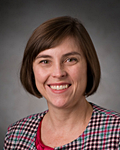Optimal Design of Self-Folding Origami
Category
Published on
Abstract
Origami engineering is a rapidly growing field where the principles of the ancient Japanese art of origami are applied to engineering problems. Applications from deployable space structures to minimally invasive surgical instruments can benefit from origami engineering. In this seminar, recent developments in the design of self-folding origami will be presented. A design framework consisting of target shape identification and rigid foldability analysis, modeling and optimization, and prototype fabrication will be described. Particular focus will be on finite element and rigid body dynamic modeling and optimization approaches for single and multi-field actuation of self-folding origami structures. These approaches will be illustrated for several applications including NASA’s starshade and a deployable probe tip for radio frequency ablation of abdominal tumors.
Bio
 Mary Frecker is a Professor of Mechanical Engineering and Biomedical Engineering and is the Associate Department Head for Graduate Programs in Mechanical and Nuclear Engineering at the Pennsylvania State University. From 2013-2015 she served as Director of the Bernard Gordon Learning Factory in the College of Engineering. Dr. Frecker has a B.S. from the University of Dayton, and an M.S. and Ph.D. in Mechanical Engineering from the University of Michigan. When she joined Penn State in 1997, she was awarded the Pearce Endowed Development Professorship in Mechanical Engineering. Dr. Frecker has also been awarded the GM/Freudenstein Young Investigator Award by the ASME Mechanisms Committee (2002), the Outstanding Advising Award by the Penn State Engineering Society (2002), the Outstanding Research Award by the Penn State Engineering Society (2005), and three Best Paper awards from the ASME Adaptive Structures and Material Systems Technical Committee (2009 and 2015). She is a Fellow of the ASME. Dr. Frecker has served as Associate Editor of the ASME Journal of Mechanical Design, Chair of the ASME Adaptive Structures and Material Systems Technical Committee, member of the ASME Mechanisms and Robotics Committee, and Executive Committee member of the ASME Aerospace Division.
Mary Frecker is a Professor of Mechanical Engineering and Biomedical Engineering and is the Associate Department Head for Graduate Programs in Mechanical and Nuclear Engineering at the Pennsylvania State University. From 2013-2015 she served as Director of the Bernard Gordon Learning Factory in the College of Engineering. Dr. Frecker has a B.S. from the University of Dayton, and an M.S. and Ph.D. in Mechanical Engineering from the University of Michigan. When she joined Penn State in 1997, she was awarded the Pearce Endowed Development Professorship in Mechanical Engineering. Dr. Frecker has also been awarded the GM/Freudenstein Young Investigator Award by the ASME Mechanisms Committee (2002), the Outstanding Advising Award by the Penn State Engineering Society (2002), the Outstanding Research Award by the Penn State Engineering Society (2005), and three Best Paper awards from the ASME Adaptive Structures and Material Systems Technical Committee (2009 and 2015). She is a Fellow of the ASME. Dr. Frecker has served as Associate Editor of the ASME Journal of Mechanical Design, Chair of the ASME Adaptive Structures and Material Systems Technical Committee, member of the ASME Mechanisms and Robotics Committee, and Executive Committee member of the ASME Aerospace Division.
Sponsored by
Cite this work
Researchers should cite this work as follows:
Time
Location
1055 WALC, Purdue University, West Lafayette, IN